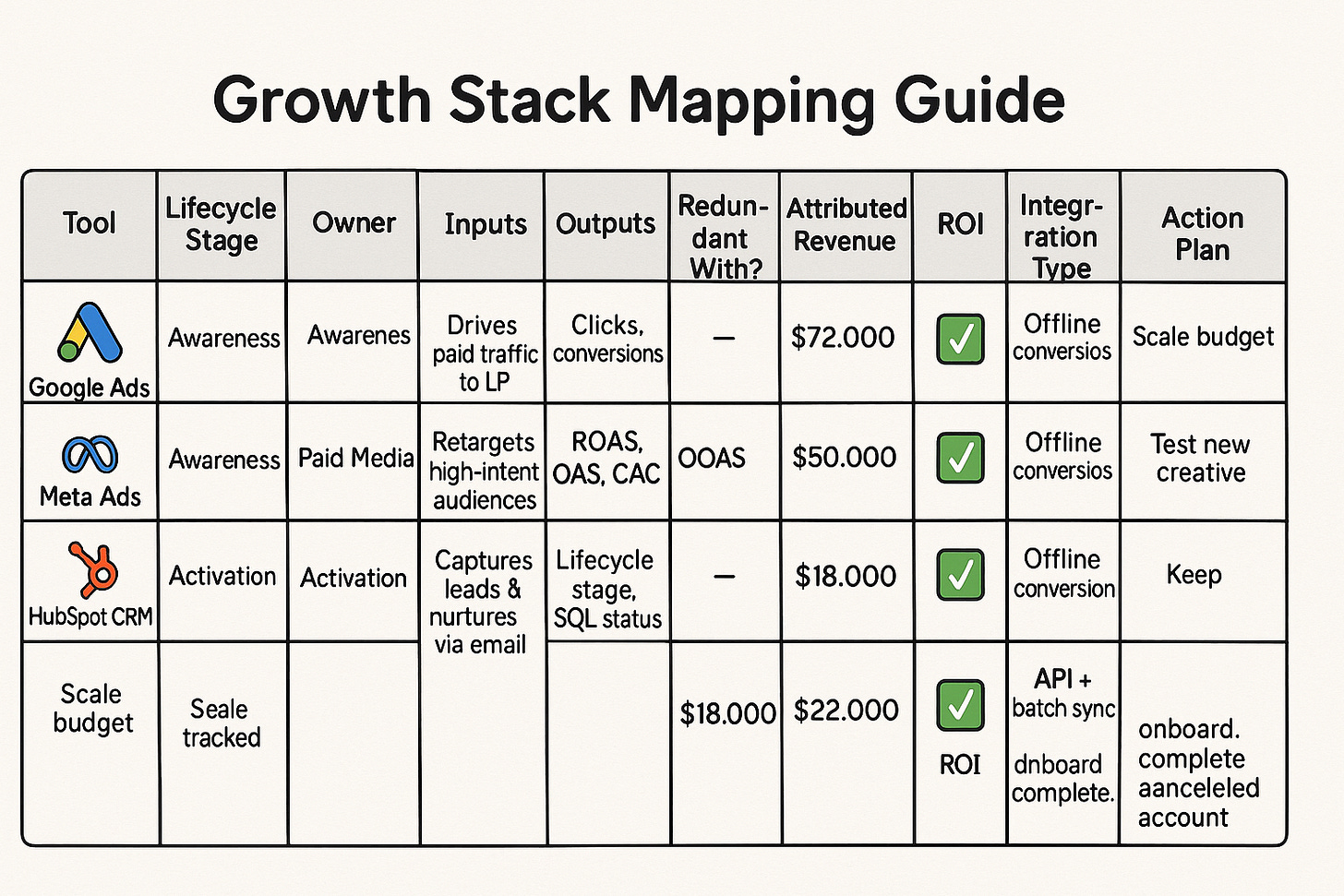A Tactical-to-Strategic Field Guide for Modern Marketing Teams
MadTech (Marketing + AdTech) becomes a growth engine only when every tool, dataset and team is wired into a single, self-optimising system.
Use this playbook to build that system—without burning budget or patience.
First, Shift Your Thinking
MadTech System: Phase-by-Phase Snapshot
Phase 1 — Discover & Map (Day 1-2)
Step 1: Identify Tool Roles Across the User Journey
Dump Your Stack – Export a list of all paid, owned, and data tools (CSV or Notion table).
Tag by Lifecycle Stage – Mark each tool as Awareness, Consideration, Activation, Retention or Loyalty.
Assign an Owner – One name per tool (no committees).
Define Single Job – One-sentence description: “Sends qualified leads to CRM,” “Tracks feature use,” etc.
List Inputs/Outputs – What data does it need? What data does it produce?
Flag Redundancies – Star any tool doing the same job as another.
ETA: 4-8 h
Outcome: Strategic clarity + tool overlap revealed
Step 2: Create a Visual Stack Map
Open Miro/Lucidchart – Drop lifecycle stages left-to-right.
Drag Tools Under Stages – Use colour codes by team owner.
Draw Data Arrows – Solid = real-time API; dashed = batch/manual.
Annotate Triggers – E.g. “Signup → Segment → HubSpot → Welcome email.”
Highlight Gaps – Red outline any missing connection or orphan tool.
Share & Confirm – Review with Product, Marketing, Data in 15-min huddle.
ETA: 1 day
Outcome: Shared blueprint to guide every integration decision
Phase 2 — Build Interoperability (Day 3-7)
Step 3: Connect Tools for Feedback Loops
Enable Server-Side Tracking – GA4 + GTM Server or Facebook CAPI.
Sync CRM to Ad Platforms – Push MQL/SQL status nightly via Zapier/API.
Feed Purchase & LTV Back – Offline Conversions to Google Ads + Meta.
Create Exclusion & Lookalike Audiences – Based on churners vs. high-LTV.
QA Conversion Match Rate – Aim > 90 % for major channels.
Set Alerting – Slack/webhook if sync fails for 24 h.
ETA:1-2 days
Outcome: Lower CAC, higher ROAS, faster optimisation loops
Step 4: Track Events, Not Pageviews
Draft 5-Event Taxonomy – e.g.
viewed_pricing,started_checkout,onboard_complete,activated_feature,canceled_account.Implement via Segment/RudderStack – Forward to GA4, ESP, Ad platforms.
Test in Dev, Then Prod – Use live debugger to validate payloads.
Create Real-Time Audiences – Trigger nurture, retargeting, in-app messages.
Dashboard Event Volume – Ensure events fire at expected rates.
Iterate Monthly – Add or retire events based on new features.
ETA: 1-2 days
Outcome: Behaviour-driven messaging & personalised retargeting
Phase 3 — Activate Growth Levers (Week 2)
Step 5: Model Attribution & LTV
Pull Raw Data – Export ad spend + conversions from GA4 or Northbeam.
Build Weighted Model – 40 % first, 20 % assist, 40 % last (starter).
Calculate 90-Day LTV – Cohort by channel/campaign in Sheets or BI tool.
Compute Payback Period – CAC ÷ 90-day LTV.
Rank Channels by Profit – Sort ascending payback.
Reallocate Budget – Shift spend from high-CAC/low-LTV to high-ROI paths.
ETA: 3-4 days
Outcome: Spend guided by profit signal, not vanity metrics
Phase 4 — Growth Operating Model (Week 3)
Step 6: Build a Lean, Lifecycle-Driven Stack
Group Tools by Stage – Awareness, Activation, Retention, Loyalty.
Add Cost & ROI Column – Annual spend vs. attributed revenue.
Colour-Code Impact – Green = high ROI; red = low/value unknown.
Retire or Replace Reds – Start with lowest impact/highest cost.
Draft 90-Day Stack Roadmap – Adds, kills, upgrades.
Share in Notion – Get sign-off from Finance & Leadership.
ETA 1 day
Outcome Lean stack, reduced cost, clearer accountability
Step 7: Launch the Monthly Growth Stack Ritual
Schedule 60-min Meeting – Owners from Marketing, Product, Data, RevOps.
Review Dashboard – Funnel drop-offs, channel LTV, tool health.
Log Wins & Friction – Quick Loom/Notion update.
Prioritise Next Experiments – ICE or PIE framework.
Assign Owners & Deadlines – Add to project board.
Update Stack Map Quarterly – Archive old, annotate new flows.
ETA 2 h/month
Outcome Continuous optimisation & shared growth memory
The Final Outcome will look like
💰 Small-Budget Starter Stack (< AU$500/mo)
🛠 5 No-BS Fast Wins
Push offline conversions to ad platforms.
Trigger onboarding and retargeting from one event source.
Use a simple 40-20-40 attribution model—done is better than perfect.
Kill any tool without an owner or KPI.
Force one monthly cross-team stack review.
Final Word
MadTech isn’t about buying more software—it’s about orchestrating behavioural data into compounding revenue.
If your tools don’t talk, your growth stalls.
Map. Connect. Measure. Iterate.
📥 Grab the Toolkit
Comment “MadTech” for:
Stack Mapper (Miro)
Attribution & LTV Sheet (Google)
Lean Stack Budget Template






